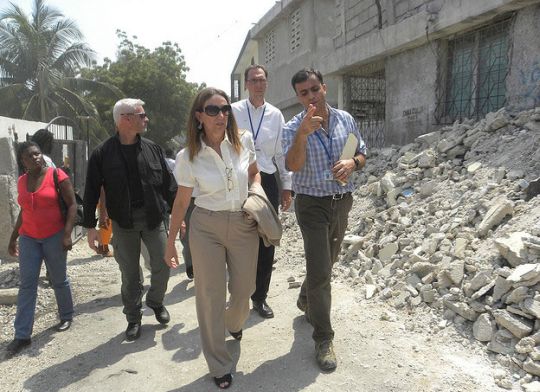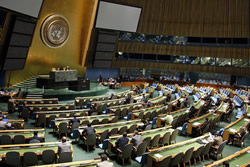Post-earthquake assistance in Haiti shifts to reconstruction – UN
Post-earthquake assistance in Haiti shifts to reconstruction – UN
 UNDP Associate Administrator Rebecca Grynspan (foreground) visits a cash-for-work project in Port-au-Prince, Haiti
UNDP Associate Administrator Rebecca Grynspan (foreground) visits a cash-for-work project in Port-au-Prince, Haiti
The allocation of resources for Haiti’s recovery from the devastating earthquake two years ago has shifted to reconstruction, infrastructure restoration, debris removal, job creation and capacity building, senior United Nations officials said today, noting, however, that considerable humanitarian needs remain.
“We… had a year of transition from the humanitarian phase to the recovery and reconstruction phases,” Rebeca Grynspan, the Associate Administrator of the UN Development Programme (UNDP), told reporters in a teleconference organized by UN Foundation to give an update on the situation in Haiti since the 12 January 2010 earthquake.
“It has been a major challenge since that we know that Haiti still needs a combination of humanitarian support… but slowly the emphasis and allocation of resources is shifting towards recovery and reconstruction,” she said.
It has been a major challenge since that we know that Haiti still needs a combination of humanitarian support… but slowly the emphasis and allocation of resources is shifting towards recovery and reconstruction.
On job creation, Ms. Grynspan said UNDP had helped create 300,000 temporary jobs since the quake, organizing people to carry out activities such as debris removal, garbage collection and enhancing disaster risk reduction. Forty per cent of the temporary jobs have gone to women.
“This has given 60,000 families possibilities to rebuild their livelihoods, have access to specialized training and cash,” she said. “This is the largest job creation programme we have in the world… 90 per cent of the labour force employed in the execution of UNDP projects is Haitian.”
Efforts are now shifting towards the creation of more sustainable jobs, moving from cash-for-work schemes to cash for production employment, according to Ms. Grynspan.
“We are supporting more and more small businesses, community-based organizations, self-employment and much more training for the labour force for them to be able to have access to the job market,” she added.
“Let us remember that one of the major challenges we face in Haiti is the long-term high rate of unemployment that has been a deeper long-standing crisis.” An estimated 60 per cent of Haiti’s labour force is unemployed, she said.
Ms. Grynspan pointed out that 50 per cent of the debris from the earthquake has been removed, and that efforts included the demolition of damaged buildings that cannot be repaired. “We are talking about five million cubic metres of debris,” she said, explaining that that was the equivalent of five football stadiums full of debris.
On disaster risk reduction, she said UNDP has supported the construction of 2,000 metres of river bank protection structures and helped 10 municipalities in the north, south and south-east of country guard against floods and river overflows during hurricanes and torrential rainfall. Some 400 hectares of land have been reforested in an effort to make the country more resilient to natural disasters.
The UN fund has also supported training programmes for 2,700 people in the country’s civil service and placed national and international experts at the disposal of Haitian Government departments to assist in recovery and capacity building.
“The local Haitian community has played a crucial role in the reconstruction effort and UNDP continues to push for a very participatory approach in its planning to allow Haitians to take control of their country and choose their own future,” said Ms. Grynspan.
On the cholera epidemic outbreak that hit Haiti 10 months after the earthquake, Jon Andrus, the Deputy Director of the UN World Health Organization’s (WHO) regional arm, the Pan-American Health Organization (PAHO), said the outbreak can only be eliminated through capacity building in health and water and sanitation infrastructure.
He pointed out that the cholera outbreak turned out to be one of the largest epidemics of the disease in modern history to affect a single country.
As of mid-December last year, Haiti had reported more than 520,000 cases and nearly 7,000 deaths. Neighbouring Dominican Republic reported more than 21,000 cases and 363 deaths over the same period, according to Dr. Andrus.
“Over the past year the response from the international community has been substantial with the implementation and promotion of a variety of prevention and control strategies,” he said. “However, despite these intensified efforts, we continue to encounter approximately 200 new cholera cases [of cholera] per day in Haiti and this number will certainly go up during the upcoming rainy season.
“Cholera elimination will require renewed efforts to ensure that safe water and sanitation are provided to every resident. Such efforts will require major investment in capacity development and infrastructure for decades. We as partners have failed to ensure safe water and sanitation is provided to every citizen of Haiti. Now we have this opportunity to reverse that failure,” said Dr. Andrus.
###
About United Nations Development Programme (UNDP)

Since 1966, the United Nations Development Programme (UNDP) has been partnering with people at all levels of society to help build nations that can withstand crisis and drive and sustain the kind of growth that improves the quality of live for everyone. UNDP works in four main areas: poverty reduction and achieving the Millennium Development Goals (MDGs); democratic governance; crisis prevention and recovery; environment and sustainable development.
UNDP is the United Nations’ global development network, an organization advocating for change and connecting countries to knowledge, experience and resources to help people build a better life. We are on the ground in 177 countries, working with them on their own solutions to global and national development challenges. As they develop local capacity, they draw on the people of UNDP and our wide range of partners.
World leaders have pledged to achieve the Millennium Development Goals, including the overarching goal of cutting poverty in half by 2015. UNDP’s network links and coordinates global and national efforts to reach these Goals.
Our focus is helping countries build and share solutions to the challenges of:
- Fighting poverty
- Building democratic societies
- Preventing crisis, enabling recovery
- Protecting the environment
- Halting & reversing HIV/AIDS
- Empowering women
- Growing national capacity
UNDP helps developing countries attract and use aid effectively. In all our activities, we encourage the protection of human rights, capacity development and the empowerment of women.
More at: www.undp.org
###
> United Nations (UN).
 The United Nations was established on 24 October 1945 by 51 countries committed to preserving peace through international cooperation and collective security. Today, nearly every nation in the world belongs to the UN: membership totals 192 countries.
The United Nations was established on 24 October 1945 by 51 countries committed to preserving peace through international cooperation and collective security. Today, nearly every nation in the world belongs to the UN: membership totals 192 countries.
When States become Members of the United Nations, they agree to accept the obligations of the UN Charter, an international treaty that sets out basic principles of international relations. According to the Charter, the UN has four purposes:
- to maintain international peace and security;
- to develop friendly relations among nations;
- to cooperate in solving international problems and in promoting respect for human rights;
- and to be a centre for harmonizing the actions of nations.
###
About World Health Organization (WHO)
WHO is the directing and coordinating authority for health within the United Nations system. It is responsible for providing leadership on global health matters, shaping the health research agenda, setting norms and standards, articulating evidence-based policy options, providing technical support to countries and monitoring and assessing health trends.
In the 21st century, health is a shared responsibility, involving equitable access to essential care and collective defence against transnational threats.
WHO fulfils its objectives through its core functions:
- providing leadership on matters critical to health and engaging in partnerships where joint action is needed;
- shaping the research agenda and stimulating the generation, translation and dissemination of valuable knowledge;
- setting norms and standards and promoting and monitoring their implementation;
- articulating ethical and evidence-based policy options;
- providing technical support, catalysing change, and building sustainable institutional capacity
- monitoring the health situation and assessing health trends.
The WHO agenda
WHO operates in an increasingly complex and rapidly changing landscape. The boundaries of public health action have become blurred, extending into other sectors that influence health opportunities and outcomes. WHO responds to these challenges using a six-point agenda. The six points address two health objectives, two strategic needs, and two operational approaches. The overall performance of WHO will be measured by the impact of its work on women’s health and health in Africa.
1. Promoting development
During the past decade, health has achieved unprecedented prominence as a key driver of socioeconomic progress, and more resources than ever are being invested in health. Yet poverty continues to contribute to poor health, and poor health anchors large populations in poverty. Health development is directed by the ethical principle of equity: Access to life-saving or health-promoting interventions should not be denied for unfair reasons, including those with economic or social roots. Commitment to this principle ensures that WHO activities aimed at health development give priority to health outcomes in poor, disadvantaged or vulnerable groups. Attainment of the health-related Millennium Development Goals, preventing and treating chronic diseases and addressing the neglected tropical diseases are the cornerstones of the health and development agenda.
2. Fostering health security
Shared vulnerability to health security threats demands collective action. One of the greatest threats to international health security arises from outbreaks of emerging and epidemic-prone diseases. Such outbreaks are occurring in increasing numbers, fuelled by such factors as rapid urbanization, environmental mismanagement, the way food is produced and traded, and the way antibiotics are used and misused. The world’s ability to defend itself collectively against outbreaks has been strengthened since June 2007, when the revised International Health Regulations came into force.
3. Strengthening health systems
For health improvement to operate as a poverty-reduction strategy, health services must reach poor and underserved populations. Health systems in many parts of the world are unable to do so, making the strengthening of health systems a high priority for WHO. Areas being addressed include the provision of adequate numbers of appropriately trained staff, sufficient financing, suitable systems for collecting vital statistics, and access to appropriate technology including essential drugs.
4. Harnessing research, information and evidence
Evidence provides the foundation for setting priorities, defining strategies, and measuring results. WHO generates authoritative health information, in consultation with leading experts, to set norms and standards, articulate evidence-based policy options and monitor the evolving global heath situation.
5. Enhancing partnerships
WHO carries out its work with the support and collaboration of many partners, including UN agencies and other international organizations, donors, civil society and the private sector. WHO uses the strategic power of evidence to encourage partners implementing programmes within countries to align their activities with best technical guidelines and practices, as well as with the priorities established by countries.
6. Improving performance
WHO participates in ongoing reforms aimed at improving its efficiency and effectiveness, both at the international level and within countries. WHO aims to ensure that its strongest asset – its staff – works in an environment that is motivating and rewarding. WHO plans its budget and activities through results-based management, with clear expected results to measure performance at country, regional and international levels.
###
* The above story is adapted from materials provided by United Nations (UN)
** More information at United Nations (UN)





















